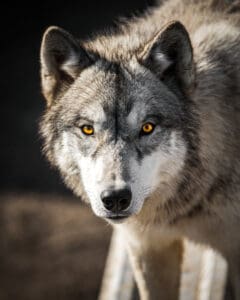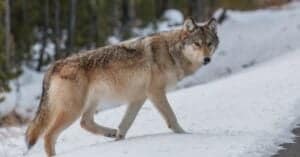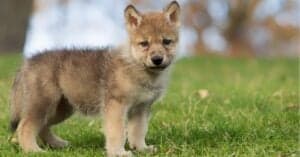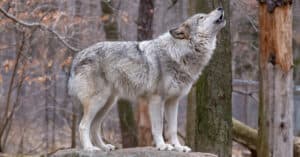Wolf Size Comparison: Just How Big are They?
When a lot of people think about wolves, they may think of them just like they would a dog. However, while the Twilight Saga might have exaggerated how big the ancestor of man’s best friend is, wolves are surprisingly bigger than many people think. But how big are they exactly? We’ve created this wolf size comparison guide to give a better look at how their size compares to humans and even prehistoric wolves like the dire wolf!
Hopefully this will give you a look at how big wolves are without getting to know one up close and personal (which isn’t recommended, especially in the wild)!
Types of Wolves and Their Sizes
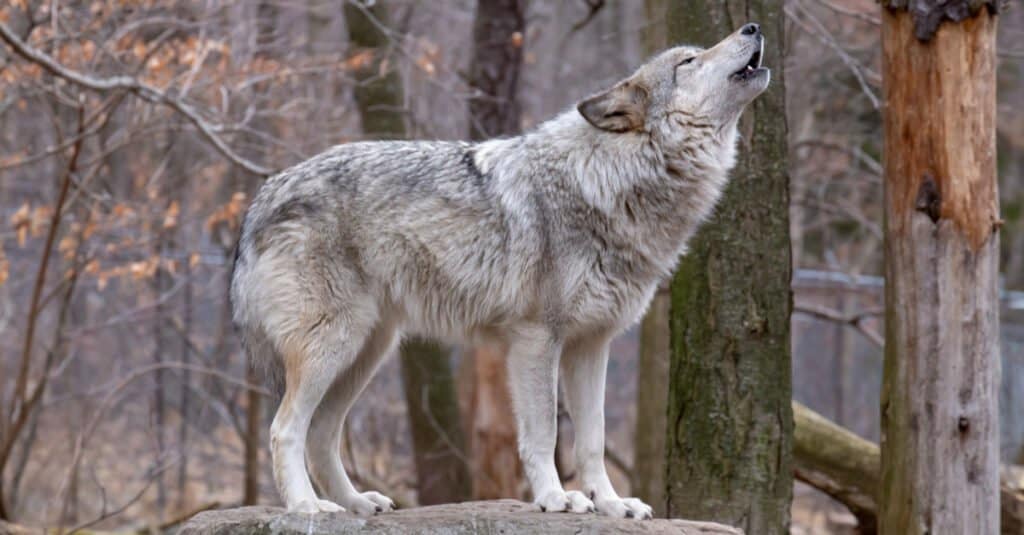
There are almost as many types or subspecies of wolves as there are dog breeds – well not exactly, but there are several found right here in North America. Most of these fall under the category of the grey wolf (also known as the gray wolf or timber wolf) and include:
- Arctic wolf (Canis lupus arctos)
- Northwestern wolf (Canis lupus occidentalis)
- Great Plains wolf (Canis lupus nubilus)
- Mexican wolf (Canis lupus baileyi)
- Eastern wolf (Canis lycaon)
There’s also the red wolf, though they’re only found in a small region in North Carolina. Red wolves tend to be much smaller than gray wolves and appear to be more closely related to a coyote with their small size of 80 pounds and length of 4 feet.
The smallest wolf is the Arabian wolf. At its full adult size, it usually only weighs an average of 45 pounds. For reference, that’s around the same as a miniature American shepherd. They also don’t tend to get larger than 25 inches at the shoulders.
However, male wolves of different species and subspecies have been known to grow past 150 pounds! In fact, the largest wolf ever recorded weighed 175 pounds!
There have also been many-a pictures taken of wolves on their hind legs seeing eye to eye with their human caretakers.
Wolf Vs. Human Size Comparison

A-Z-Animals.com
Did you know wolf attacks on humans are one of the rarest of all top predators? Even wild sightings are rare because of how wary they are of humans. However, if you were to come across one by chance, how do you think you’ll measure up against them?
If you were to happen to come across the Arabian wolf, it would be similar to meeting a Labrador retriever – at least in size. For an adult, this means that they would most likely be at eye level with your upper knee.
However, for some of the largest species of wolf, you may find that they come up to your waist. And, if they were to stand on their hind legs, they would likely be able to rest their front paws on your shoulder and be at eye level with you. Talk about the most dangerous hug.
Wolf Size Comparison to a Great Dane

A-Z-Animals.com
Titan, one of the largest Great Danes ever, held the record for having a shoulder height of 42 inches. While this outshines even the largest of the wolves, who usually don’t boast more than a maximum of 32 inches (about 1 envelop length shorter than Titan the Great Dane).
But do wolves stand a chance against the average Great Dane?
For the female Great Dane, it’s a close maybe. Females have an average height of 28 to 32 inches, with an estimated maximum of 130 pounds. Larger wolves, such as the timber wolf or Mackenzie Valley wolf, may be larger than this, but smaller species like the tundra wolf, Mexican wolf, or Arabian wolf would be a few inches shorter.
Wolf Size Comparison to a Coyote
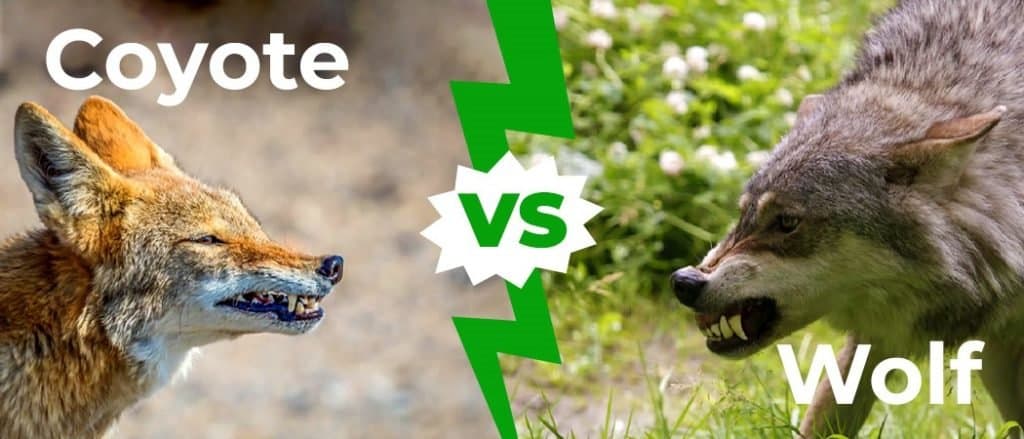
A-Z-Animals.com
Depending on your region, it can be difficult to tell a wolf from a coyote due to their similarities. One of their few differentiating qualities is their size – or the coyote’s lack thereof.
A close match for many of North America’s top predators, wolves, especially timber or grey wolves, are known for their lean but large size. In fact, with coyotes only reaching a maximum weight of 50 pounds, grey wolves are nearly double their size. Wolves also tend to be around a foot taller than coyotes, meaning that they won’t exactly see eye to eye unless the wolf drops into an offensive, snarling position (and who wants to be on the other side of that?).
From snout to tail, wolves also win in length by growing up to 5 to 6 feet long – the average height of an adult human. Coutotes, on the other hand, usually don’t get any longer than around 4 feet, the average height of a five-year-old child.
There’s even a difference in the size of their paws! On average, wolf paws are exactly double the size coyote’s paw – all the better to support their larger bodies with.
Wolf Size Comparison to a Dire Wolf

Aunt Spray/Shutterstock.com
That’s right: dire wolves exist beyond the world of your favorite fantasy shows. Or at least, they did.
While they’re extinct now, and have been for tens of thousands of years, dire wolves used to be one of the top predators in America and Asia, and they’re the ancestors of modern-day wolves. Surprisingly though, there aren’t too many differences between these canine family members, even when analyzing and comparing their sizes.
Dire wolves are most comparable to the gray wolf, where they’re a tad bit heavier. To be more specific, the lean and athletic gray wolf usually maxes out around 145 pounds, while dire wolves were known to be bulky, strong hunters with an estimated maximum weight of 175 pounds. In general, dire wolves were about 25% heavier than today’s gray wolves.
While they tend to see eye to eye when it comes to height, dire wolves were known for their large skulls and jaws, which has the opportunity to give them a height advantage over the gray wolf.
The largest wolf subspecies today would be the Mackenzie wolf. As noted earlier, the largest one ever caught weighed 175 pounds, meaning the wolves in the Yukon territory and Alaska could be the closest modern approximations of dire wolves!
More from A-Z Animals
When a lot of people think about wolves, they may think of them just like they would a dog. However, while the Twilight Saga might have exaggerated how big the ancestor of man’s best friend is, wolves are surprisingly bigger than many people think. But how big are they exactly? We’ve created this wolf size comparison guide to give a better look at how their size compares to humans and even prehistoric wolves like the dire wolf!
Hopefully this will give you a look at how big wolves are without getting to know one up close and personal (which isn’t recommended, especially in the wild)!
Types of Wolves and Their Sizes

There are almost as many types or subspecies of wolves as there are dog breeds – well not exactly, but there are several found right here in North America. Most of these fall under the category of the grey wolf (also known as the gray wolf or timber wolf) and include:
- Arctic wolf (Canis lupus arctos)
- Northwestern wolf (Canis lupus occidentalis)
- Great Plains wolf (Canis lupus nubilus)
- Mexican wolf (Canis lupus baileyi)
- Eastern wolf (Canis lycaon)
There’s also the red wolf, though they’re only found in a small region in North Carolina. Red wolves tend to be much smaller than gray wolves and appear to be more closely related to a coyote with their small size of 80 pounds and length of 4 feet.
The smallest wolf is the Arabian wolf. At its full adult size, it usually only weighs an average of 45 pounds. For reference, that’s around the same as a miniature American shepherd. They also don’t tend to get larger than 25 inches at the shoulders.
However, male wolves of different species and subspecies have been known to grow past 150 pounds! In fact, the largest wolf ever recorded weighed 175 pounds!
There have also been many-a pictures taken of wolves on their hind legs seeing eye to eye with their human caretakers.
Wolf Vs. Human Size Comparison

A-Z-Animals.com
Did you know wolf attacks on humans are one of the rarest of all top predators? Even wild sightings are rare because of how wary they are of humans. However, if you were to come across one by chance, how do you think you’ll measure up against them?
If you were to happen to come across the Arabian wolf, it would be similar to meeting a Labrador retriever – at least in size. For an adult, this means that they would most likely be at eye level with your upper knee.
However, for some of the largest species of wolf, you may find that they come up to your waist. And, if they were to stand on their hind legs, they would likely be able to rest their front paws on your shoulder and be at eye level with you. Talk about the most dangerous hug.
Wolf Size Comparison to a Great Dane

A-Z-Animals.com
Titan, one of the largest Great Danes ever, held the record for having a shoulder height of 42 inches. While this outshines even the largest of the wolves, who usually don’t boast more than a maximum of 32 inches (about 1 envelop length shorter than Titan the Great Dane).
But do wolves stand a chance against the average Great Dane?
For the female Great Dane, it’s a close maybe. Females have an average height of 28 to 32 inches, with an estimated maximum of 130 pounds. Larger wolves, such as the timber wolf or Mackenzie Valley wolf, may be larger than this, but smaller species like the tundra wolf, Mexican wolf, or Arabian wolf would be a few inches shorter.
Wolf Size Comparison to a Coyote

A-Z-Animals.com
Depending on your region, it can be difficult to tell a wolf from a coyote due to their similarities. One of their few differentiating qualities is their size – or the coyote’s lack thereof.
A close match for many of North America’s top predators, wolves, especially timber or grey wolves, are known for their lean but large size. In fact, with coyotes only reaching a maximum weight of 50 pounds, grey wolves are nearly double their size. Wolves also tend to be around a foot taller than coyotes, meaning that they won’t exactly see eye to eye unless the wolf drops into an offensive, snarling position (and who wants to be on the other side of that?).
From snout to tail, wolves also win in length by growing up to 5 to 6 feet long – the average height of an adult human. Coutotes, on the other hand, usually don’t get any longer than around 4 feet, the average height of a five-year-old child.
There’s even a difference in the size of their paws! On average, wolf paws are exactly double the size coyote’s paw – all the better to support their larger bodies with.
Wolf Size Comparison to a Dire Wolf

Aunt Spray/Shutterstock.com
That’s right: dire wolves exist beyond the world of your favorite fantasy shows. Or at least, they did.
While they’re extinct now, and have been for tens of thousands of years, dire wolves used to be one of the top predators in America and Asia, and they’re the ancestors of modern-day wolves. Surprisingly though, there aren’t too many differences between these canine family members, even when analyzing and comparing their sizes.
Dire wolves are most comparable to the gray wolf, where they’re a tad bit heavier. To be more specific, the lean and athletic gray wolf usually maxes out around 145 pounds, while dire wolves were known to be bulky, strong hunters with an estimated maximum weight of 175 pounds. In general, dire wolves were about 25% heavier than today’s gray wolves.
While they tend to see eye to eye when it comes to height, dire wolves were known for their large skulls and jaws, which has the opportunity to give them a height advantage over the gray wolf.
The largest wolf subspecies today would be the Mackenzie wolf. As noted earlier, the largest one ever caught weighed 175 pounds, meaning the wolves in the Yukon territory and Alaska could be the closest modern approximations of dire wolves!

